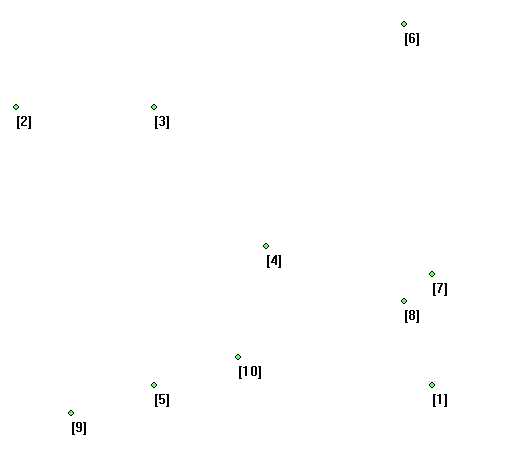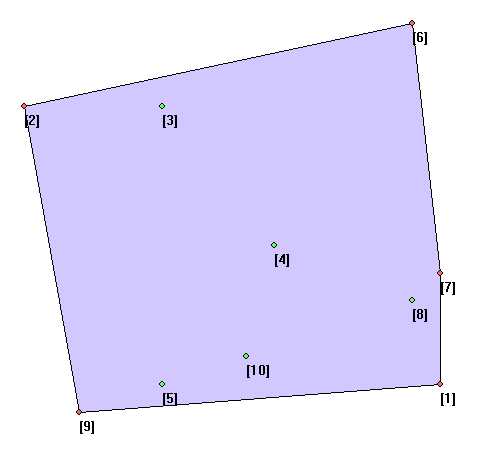标签:
题目链接:http://dsa.cs.tsinghua.edu.cn/oj/problem.shtml?id=710
After learning Chapter 1, you must have mastered the convex hull very well. Yes, convex hull is at the kernel of computational geometry and serves as a fundamental geometric structure. That‘s why you are asked to implement such an algorithm as the first of your programming assignments.
Specifically, given a set of points in the plane, please construct the convex hull and output an encoded description of all the extreme points.
经过了第一章的学习,想必你对于凸包的认识已经非常深刻。是的,凸包是计算几何的核心问题,也是一种基础性的几何结构。因此你的第一项编程任务,就是来实现这样的一个算法。
具体地,对于平面上的任意一组点,请构造出对应的凸包,并在经过编码转换之后输出所有极点的信息。
The first line is an integer n > 0, i.e., the total number of input points.
The k-th of the following n lines gives the k-th point:
pk = (xk, yk), k = 1, 2, ..., n
Both xk and yk here are integers and they are delimited by a space.
第一行是一个正整数首行为一个正整数n > 0,即输入点的总数。
随后n行中的第k行给出第k个点:
pk = (xk, yk), k = 1, 2, ..., n
这里,xk与yk均为整数,且二者之间以空格分隔。
Let { s1, s2, ..., sh } be the indices of all the extreme points, h ≤ n. Output the following integer as your solution:
( s1 * s2 * s3 * ... * sh * h ) mod (n + 1)
若 { s1, s2, ..., sh } 为所有极点的编号, h ≤ n,则作为你的解答,请输出以下整数:
( s1 * s2 * s3 * ... * sh * h ) mod (n + 1)
10
7 9
-8 -1
-3 -1
1 4
-3 9
6 -4
7 5
6 6
-6 10
0 8

7 // ( 9 x 2 x 6 x 7 x 1 x 5 ) % (10 + 1)

CH algorithms presented in the lectures
课程中讲解过的凸包算法
真TM历经波折啊。。。一直找不到坑在哪?
题意:求凸包极点个数,然后求一表达式。
题解:Andrew 水平序扫描,O(logn)。
坑点:
1.注意共线情况:只需将小于等于变为小于保留共线情况即可。
Cross(ch[m-1]-ch[m-2], p[i]-ch[m-2])<0
#include<stdio.h>
#include<algorithm>
using namespace std;
const int MAX=100000+5;
typedef long long LL;
int n;
struct Point
{
LL x,y;
int pos;
Point(LL x=0,LL y=0,int p=0):x(x),y(y),pos(p) {}
} p[MAX],ch[MAX];
typedef Point Vector;
Vector operator + (Vector A, Vector B)
{
return Vector(A.x + B.x, A.y + B.y);
}
Vector operator - (Vector A, Vector B)
{
return Vector(A.x - B.x, A.y - B.y);
}
bool operator == (const Vector& A, const Vector& B)
{
return A.x-B.x==0 && A.y-B.y==0;
}
LL Cross(Vector A, Vector B)
{
return A.x * B.y - A.y * B.x;
}
bool cmp(Point A, Point B)
{
if(A.x != B.x) return A.x < B.x;
else return A.y < B.y;
}
int ConvexHull()
{
sort(p+1,p+n+1,cmp);
int m = 0;
for(int i = 1; i <= n; i++)
{
while(m > 1 && Cross(ch[m-1]-ch[m-2], p[i]-ch[m-2]) < 0) m--;
ch[m++] = p[i];
}
if(m==n) return n;
int k = m;
for(int i = n-1; i >=1; i--)
{
while(m > k &&Cross(ch[m-1]-ch[m-2], p[i]-ch[m-2]) < 0) m--;
ch[m++] = p[i];
}
if(n > 1) m--;
return m;
}
int main()
{
int m;
while(scanf("%d",&n)!=EOF)
{
for(int i = 1; i <= n; i++)
{
LL a,b;
scanf("%lld%lld",&a,&b);
p[i] = Point(a,b,i);
}
m = ConvexHull();
//printf("%d\n",m);
LL ans=1;
for(int i=0; i<m; i++)
ans=((ans%(n+1))*(ch[i].pos%(n+1)))%(n+1);
ans=((ans%(n+1))*(m%(n+1)))%(n+1);
printf("%lld\n",ans);
}
return 0;
}
Computational Geometry PA1 Convex Hull (凸包)
标签:
原文地址:http://www.cnblogs.com/jiajiawangacm/p/4932581.html